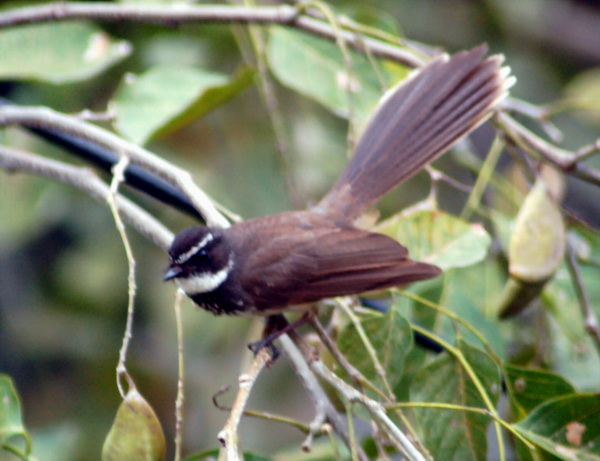|
| Query: Bird notes | Result: 20th of 662 | |
White-throated Fantail (Rhipidura albicollis) - Wiki
| Subject: | White-throated Fantail (Rhipidura albicollis) - Wiki
| |

| Resolution: 600x461
File Size: 99983 Bytes
Date: 2007:07:26 07:29:37
Camera: NIKON D50 (NIKON CORPORATION)
F number: f/5.7
Exposure: 10/2000 sec
Focal Length: 3000/10
Upload Date: 2007:09:13 15:23:25
|
White-throated Fantail
From Wikipedia, the free encyclopedia
[Photo] White-throated Fantail (Rhipidura albicollis). White Throated Fantail Flycatcher : Rhipidura albicollis. Date July 23, 2007. Author Ravivaidya http://commons.wikimedia.org/wiki/User:Ravivaidya
The White-throated Fantail, Rhipidura albicollis, is a small passerine bird . It was previously classified with the Old World flycatcher family Muscicapidae, but the paradise flycatchers, monarch flycatchers and Australasian fantails are now normally grouped with the drongos in the family Dicruridae, which has most of its members in Australasia and tropical southern Asia.
The White-throated Fantail breeds across tropical southern Asia from the Himalayas, India and Bangladesh east to Indonesia. This species is found in forest, scrub and cultivation. Three eggs are laid in a small cup nest in a tree.
The adult White-throated Fantail is about 19 cm long. It has a dark fan-shaped tail, edged in white, and white supercilium and throat. There is otherwise much variation in plumage between races. For example, the Himalayan R. a. canescans is mainly slate grey above and below, with a black eye mask, whereas R. a. albogularis of peninsular India has dark grey upperparts, whitish underparts, and a grey breast band.
The White-throated Fantail is insectivorous, and often fans its tail as it moves through the undergrowth.
Not normally renowned as a songster, the male of R.a.albogularis, the peninsular race uses a fixed and unmistakable pattern of musical notes in its call. The notes are loud and normally divided into two stanzas - the first with 5-6 trilling notes rising and falling followed by 4-5 notes rising up the scale and ending in the highest note. Birds use the same song year after year with small changes progressiveley made, with the sesult that the song sounds very different after 4-5 years. The male's call is a valuable tool in detection and identification of the bird, which can often be confused with R.aureola ( White Browed Fantail Flycatcher ) where their ranges overlap. R.aureola has light underparts and prominent spots in two rows on the wings and the call is rather functional and not as pleasant and aesthetic as that of R.albicollis.
http://en.wikipedia.org/wiki/White-throated_Fantail
| The text in this page is based on the copyrighted Wikipedia article shown in above URL. It is used under the GNU Free Documentation License. You may redistribute it, verbatim or modified, providing that you comply with the terms of the GFDL. |
|
^o^
Animal Pictures Archive for smart phones
^o^
|
|

